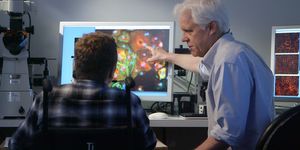Brain Mapping The Physicists' Way (Part II)
Quantum mechanics is a fundamental theory in physics which describes the microscopic nature of atoms and subatomic particles. Now some physicists think the phenomenon and rules in the quantum mechanics can also be applied to brain function and consciousness. Cue in the concept of quantum mind.
Quantum mind, or quantum consciousness, is a group of hypotheses proposes that quantum mechanical phenomena, such as quantum entanglement and superposition, may play an important part in the brain's function and could form the basis of an explanation of consciousness.
An often-controversial quantum consciousness theorist (and anesthesiologist, yes he is a medical doctor) Stuart Hameroff was featured In the latest issue of the Discover magazine. Hameroff rose to fame with his idea of microtubules-based quantum behavior in the mid-1990s. What is surprising, he has a world-renowned co-theorist Oxford’s theoretical physicist Sir Roger Penrose. They collaborated to produce the theory known as Orchestrated Objective Reduction (Orch-OR), with ideas they initially developed separately.
Orch-OR hypothesizes that microtubules would be suitable hosts for quantum behavior. Microtubules are composed of tubulin protein dimer subunits. The dimers each have hydrophobic pockets that are 8 nm apart, and that may contain delocalized pi electrons.
Hameroff and Penrose are not alone in the field of this contentious subject. When Matthew Fisher, a physicist at the University of California, Santa Barbara, first published a paper proposing that the nuclear spins of phosphorus atoms could serve as rudimentary “qubits” (the basic unit of information in a quantum computer) in the brain, he faced a lot of backlashes and his idea of neural qubits was mocked as equivalent if no less than just “pixie dust in the synapses”
Fisher’s hypothesis revolves around on a phenomenon called quantum decoherence. To build an operating quantum computer, one needs to connect qubits in a process called entanglement. But the entanglement of qubits can only exist in an environment with zero electromagnetic noise. Just one photon can destroy the entanglement and wipe out the quantum properties of the system. Therefore, many believed that in the warm, wet tissues such as a human brain, it’s impossible to maintain coherence long enough allow quantum computing.
Over the past decade, however, growing evidence suggests that certain biological systems might employ quantum mechanics. For example, photosynthesis was found to have quantum effects which help plants turn sunlight into fuel; it was also suspected that Migratory birds have a “quantum compass” that allows them to sue Earth’s magnetic fields for navigation. The idea that human consciousness can be the product of quantum mechanisms happening inside the brain become more plausible than previously supposed and some researchers are starting to pay attention.
While theorists have been busy modeling and exploring the working mechanisms that underpin brain function, engineers have started integrating the knowledge to with computing technologies and artificial intelligence.
At the 2018 Consumer Electronics Show (CES), the Computer Processor giant Intel announced two major milestones in its efforts to research and develop future computing technologies. One of them is neuromorphic computing—a new computing paradigm inspired by how the brain works that could unlock exponential gains in performance and power efficiency for the future of artificial intelligence.
Neuromorphic engineering, also known as neuromorphic computing, is a concept that describes the use of very-large-scale integration (VLSI) systems containing electronic analog circuits to mimic neuro-biological architectures present in the nervous system.
Explore further: 2018 CES: Neuromorphic Computing Mimics the Human Brain
Intel has come up with a neuromorphic research chip, which has digital circuits that mimic the brain's basic operation. It combines training and inference on a single chip with the goal of making machine learning more power efficient. Intel CEO Brian Krzanich noted the significance of this research and the progress Intel is making. "This has been a major research effort by Intel and today we have a fully functioning neuromorphic research chip," he said. "This incredible technology adds to the breadth of AI solutions that Intel is developing."
Is Your Mind Quantum? | Roger Penrose Ph.D. Credit: metaRising
Source: quanta magazine/discover magazine/phys.org









